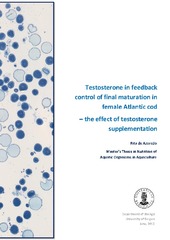| dc.description.abstract | Atlantic cod is a species of very high fecundity and it spawns rather easily and spontaneously in captivity. However husbandry routines, diets, females/males imbalances and stress are believed to be the causes of high mortalities following spawning failure of female cod that become egg-bound. The mechanism behind these events is still not well understood and every possible approach is to be explored. One of these approaches and one of the goals of this thesis is to look deeper at the role of testosterone in cod oocyte growth and maturation by observing the effect of an extra-dose on estradiol-17β levels and oocyte size and stages. Since prostaglandins are known to play an important part in other fish species' oocyte maturation and ovulation, their role in cod ovarian cycle modulation as well as their response to high testosterone levels has been studied. Three groups of fish were considered: a testosterone group of fish, implanted with testosterone-releasing tubes (n=13), a sham group, in which fish were implanted with the same but empty tube (n=15) and a control group, in which fish were not subjected to any treatment (n=42). The experiment lasted for 23 days. From gonad samples, oocytes were embedded in resin, sectioned and stained in 2 % toluidine blue and 1 % borax, for stages classification and diameter measurements. Blood steroids, testosterone and estradiol, were analysed by Enzyme-linked Immunosorbent Assay and prostaglandins PGE2, PGE3, and PGF2 were extracted, separated and quantified by Liquid Chromatography Ion-Trap Mass Spectrometry. A very high variance was observed both in steroid and prostaglandin levels. After the experiment, the group treated with testosterone had higher testosterone levels in plasma than both the sham and control group. Higher levels of testosterone did not affect estradiol-17β suggesting that the extra-testosterone was not used as an estradiol-17β precursor. Testosterone did not affect prostaglandin levels and steroids were not correlated with prostaglandins suggesting that ovarian prostaglandins are not regulated by steroids. The three prostaglandins were positively correlated in the control group. PGF2α concentrations were the highest in the three groups while PGE2 and PGE3 exhibited very low and similar levels corresponding to a ratio very close to 1. Positive correlation between PGE2/PGE3 ratio and the steroids suggests a regulatory role of prostaglandins in steroidogenesis. | en_US |
